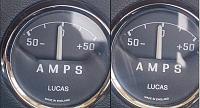 
 Main Menu
Main Menu
|
 Nevada Classics
Nevada Classics
|
 Advertise at CC
Advertise at CC
|
| S |
M |
T |
W |
T |
F |
S |
| |
|
|
|
|
|
1 |
| 2 |
3 |
4 |
5 |
6 |
7 |
8 |
| 9 |
10 |
11 |
12 |
13 |
14 |
15 |
| 16 |
17 |
18 |
19 |
20 |
21 |
22 |
| 23 |
24 |
25 |
26 |
27 |
28 |
|
|
 CC Advertisers
CC Advertisers
|
|
 2Likes 2Likes
-
 1
Post By patrickt
1
Post By patrickt
-
 1
Post By DanEC
1
Post By DanEC

08-22-2023, 02:51 PM
|
 |
CC Member

|
|
|
Join Date: Nov 2007
Location: Clayton,
IN
Cobra Make, Engine: ERA 838
Posts: 1,126
|
|

 Not Ranked
Not Ranked
 Ammeter Shunt wire / No charge
Ammeter Shunt wire / No charge
838 is complete and I am doing some things that improve the car.
I installed an Ammeter shunt wire to protect the system. It is a 12 gauge wire run from the protected side of circuit breaker, that is near the starter solenoid, to the powered side of fuse 1. Fuse 1 runs the cooling fans. This basically connects the two sides of the Ammeter gauge.
With the shunt wire installed the Ammeter reacts like I would expect. The needle swings much less than without. It is easy to see the difference with the engine off and load applied.
The problem is, it will not charge. It will stay in a slight discharge. I don't see how this could impact the voltage regulator.
I would like to have the shunt wire, but normal charging is important.
John
|

08-22-2023, 03:42 PM
|
 |
Half-Ass Member

|
|
|
Join Date: Jun 2005
Cobra Make, Engine: ERA #732, 428FE (447 CID), TKO600, Solid Flat Tappet Cam, Tons of Aluminum
Posts: 22,014
|
|

 Not Ranked
Not Ranked
Quote:
Originally Posted by Grubby

838 is complete and I am doing some things that improve the car.
I installed an Ammeter shunt wire to protect the system.
...
I would like to have the shunt wire, but normal charging is important.
|
Well, you can't rely on your eyes on this one, you have to test and take measurements. Let me just make a wild guess and say that the resistance on your new shunt wire is wayyyyyyy less than the resistance in the wire that is running through your ammeter. If that's the case then most of the current, regardless of which way it's flowing, is going through that wire and a much smaller, but proportionate, amount is running through your original wire. To test that out, and with the car engine OFF, turn on your lights and your fans, both pushers and pullers, that's 30+ amps flowing out of the battery. How far to the minus sign has your ammeter needle moved from the straight up position? |

08-22-2023, 05:16 PM
|
 |
CC Member

|
|
|
Join Date: Nov 2007
Location: Clayton,
IN
Cobra Make, Engine: ERA 838
Posts: 1,126
|
|

 Not Ranked
Not Ranked
Patrick,
Fans and head lights on; approximately 30 amps with the shunt removed and approximately 10 amps with the shunt attached.
On a short road trip with the shunt installed. The ammeter stayed in a very small discharge for 40 miles (a few amps). I stopped and unhooked one end and the ammeter went the 40+ amps for several minutes. That tells me the battery was really discharging. I didn't have a voltmeter with me to check.
John
|

08-22-2023, 05:19 PM
|
 |
Half-Ass Member

|
|
|
Join Date: Jun 2005
Cobra Make, Engine: ERA #732, 428FE (447 CID), TKO600, Solid Flat Tappet Cam, Tons of Aluminum
Posts: 22,014
|
|

 Not Ranked
Not Ranked
OK, 12 gauge wire running to the powered side of the #1 fuse. That's exactly how I have mine. If putting a voltmeter on your battery shows you're getting about 14.5 volts when revving to 2000 RPM then you're definitely charging. If your ammeter shows you're not charging then either the ammeter is not working right or current is not flowing properly in that wire in that direction.
Last edited by patrickt; 08-22-2023 at 05:26 PM..
|

08-22-2023, 05:37 PM
|
 |
Half-Ass Member

|
|
|
Join Date: Jun 2005
Cobra Make, Engine: ERA #732, 428FE (447 CID), TKO600, Solid Flat Tappet Cam, Tons of Aluminum
Posts: 22,014
|
|

 Not Ranked
Not Ranked
And the charging light is not lit... ok put a voltmeter on the battery with the engine running at 2000 RPM and confirm your getting 14+ volts. If you are, and your ammeter is still showing a discharge then we'll need to put an inductive ammeter around both lines, and the fat brown wire that leads to the bottom of the circuit breaker from the solenoid, to measure the current in each. The current in the fat brown wire will equal the sum of the original ammeter wire and your new shunt wire (that's Kirchhoff’s Law). The difference in the two will be in proportion to the resistance of the two. What you are looking for is to make sure there's no unusual amount of resistance in your ammeter wire.
|

08-22-2023, 06:34 PM
|
 |
Half-Ass Member

|
|
|
Join Date: Jun 2005
Cobra Make, Engine: ERA #732, 428FE (447 CID), TKO600, Solid Flat Tappet Cam, Tons of Aluminum
Posts: 22,014
|
|

 Not Ranked
Not Ranked
So let's say that we measure the current going through the two parallel lines (the 12 gauge shunt wire and the 10 gauge ammeter wire) on a 30 amp load, or a 30 amp charge, which will occur right after starting your car after a couple of long cranks, and 25 amps are going through your shunt wire and 5 amps are going through your ammeter wire. That would tell us there is too much resistance in your ammeter wire. That could be from a bad connection, a faulty wire or the ammeter itself. If you then put a short wire with two alligator clips across your ammeter and the two current values even out then that would tell you the resistance is in the gauge itself. Now, OTOH, if just putting a shunt wire across completely stops the charging circuit, but doesn't illuminate the idiot light in the process, then on that I'd have to noodle.  |

08-22-2023, 07:16 PM
|
 |
Half-Ass Member

|
|
|
Join Date: Jun 2005
Cobra Make, Engine: ERA #732, 428FE (447 CID), TKO600, Solid Flat Tappet Cam, Tons of Aluminum
Posts: 22,014
|
|

 Not Ranked
Not Ranked

I just checked mine. With the engine off, when I turn my headlights, SPAL puller and pusher fans on I draw 30 amps through the fat brown wire at the bottom of the circuit breaker. My 12 gauge shunt wire has 18 amps running through it and the 10 gauge ammeter wire has 12 amps running through it. On my Smiths ammeter it appears that needle movements are roughly half of what they were before I made the change. So to the naked eye on these crappy Smiths ammeters, 12 actually looks to be roughly half of 30. And now that I think about it, that Smiths ammeter has never pointed directly up at zero even when the gauge was out of the car.  It's always been skewed an amp or two towards the minus side. Anyway, these figures show that my shunt wire gives a current ratio reduction of 60%, so what used to be a 20 amp charge now appears to be almost ten, a ten amp charge now shows as a 4 amp charge, and a 2 amp charge shows as a 1 amp charge. The significance decreases as the charge/discharge gets closer to zero and that 60% ratio moves closer to 50% when the under hood temps are 200 degrees and the under dash temps are 80 degrees. |

08-23-2023, 05:44 AM
|
|
CC Member

|
|
|
Join Date: Nov 2003
Location: New Britain,
CT
Cobra Make, Engine: Size 10 Feet
Posts: 3,021
|
|

 Not Ranked
Not Ranked
The shunt has nothing to do with charging function. If it's not charging, there is a problem elsewhere. For testing, see the troubleshooting section in my Wiring Primer:
https://erareplicas.com/427man/wiring/wprimer.pdf |

08-23-2023, 06:55 AM
|
 |
CC Member

|
|
|
Join Date: Apr 2009
Location: Little Rock area,
AR
Cobra Make, Engine: ERA Street Roadster #782 with 459 cu in FE KC engine, toploader, 3.31
Posts: 4,527
|
|

 Not Ranked
Not Ranked
I installed the shunt on #782 and it functions/charges fine. I originally had charging issues with my car but it appeared to be an issue with the red light indicator circuit not being able to excite the alternator to charge. I believe Bob provided a resister to increase resistance in the circuit - but I’m too dumb on electrical stuff to swear that’s an accurate description. But sounds like you think your car is charging normally w/o the shunt?
|

08-23-2023, 12:14 PM
|
 |
CC Member

|
|
|
Join Date: Nov 2007
Location: Clayton,
IN
Cobra Make, Engine: ERA 838
Posts: 1,126
|
|

 Not Ranked
Not Ranked
Answer found.
Look at the attached photo. The ammeter on the Right is engine off and I also pulled the battery disconnect and it stayed like this. The ammeter on the Left is engine idling. Since the needle is showing ~5amp discharge when it is really 0 and ~2.5amp discharge when it is really charging, I have a gauge that isn't zeroed correctly.
In addition, the system is charging per my trusty Fluke (14.8v running). I also checked battery voltage engine off at 12.6v, then went for a 30 mile run with lights and cooling fans running. Upon return voltage was still 12.6v.
The gauge needle is shifted to the discharge range. I don't think it was like that when I completed the car.
The shunt works as it should. I guess I will monitor the ammeter and replace if it gets worse.
Thanks Patrick, Bob and Dan for the advice.

John
Last edited by Grubby; 08-23-2023 at 12:21 PM..
Reason: typo left to right
|

08-23-2023, 12:49 PM
|
 |
Half-Ass Member

|
|
|
Join Date: Jun 2005
Cobra Make, Engine: ERA #732, 428FE (447 CID), TKO600, Solid Flat Tappet Cam, Tons of Aluminum
Posts: 22,014
|
|

 Not Ranked
Not Ranked
Yep, you can't trust your eyes on this one -- and a LUCAS ammeter is worse than a Smiths.  I think you will find that you've reduced your current by a good 50% to 60% going through the ammeter. An inductive ammeter tool is really wonderful to have on your work shelf -- you really ought to put that on your Christmas list.  |

08-23-2023, 01:32 PM
|
 |
CC Member

|
|
|
Join Date: Apr 2009
Location: Little Rock area,
AR
Cobra Make, Engine: ERA Street Roadster #782 with 459 cu in FE KC engine, toploader, 3.31
Posts: 4,527
|
|

 Not Ranked
Not Ranked
The ammeter shunt is a great modification. I would go for a drive and pull up to a light for a minute and out of the corner of my eye see the gage flick all the way left momentarily and my heart would skip a beat and then a few seconds later I would remember oh yeah, that’s my cooling fan kicking on. With the shunt it’s just a small flicker, kind of like a turn signal flashing.
|

08-23-2023, 04:14 PM
|
 |
CC Member

|
|
|
Join Date: Nov 2007
Location: Clayton,
IN
Cobra Make, Engine: ERA 838
Posts: 1,126
|
|

 Not Ranked
Not Ranked
I think the shunt is a good idea to. 60's cars have been known to have issues from ammeter shorts.
This is a good safety upgrade.
John
|

08-23-2023, 07:24 PM
|
 |
CC Member

|
|
|
Join Date: Apr 2009
Location: Little Rock area,
AR
Cobra Make, Engine: ERA Street Roadster #782 with 459 cu in FE KC engine, toploader, 3.31
Posts: 4,527
|
|

 Not Ranked
Not Ranked
Yes, I have a 66 and 67 Plymouth with nearly full amps run through a cheap, factory amp gage. Too many of them have succumbed to electrical fires over the years.
|

08-24-2023, 06:25 AM
|
|
CC Member

|
|
|
Join Date: Nov 2003
Location: New Britain,
CT
Cobra Make, Engine: Size 10 Feet
Posts: 3,021
|
|

 Not Ranked
Not Ranked
I haven't taken one apart, but I suspect that all ammeters have an internal shunt. The coil that works the needle only needs milliamps. My external shunt just adds to what's internal.
|

08-24-2023, 11:46 AM
|
|
CC Member

|
|
|
Join Date: Aug 2011
Cobra Make, Engine: ERA 427
Posts: 88
|
|

 Not Ranked
Not Ranked
When I sit at a traffic light with the turn signals on waiting for the light to change my Lucas ammeter rocks back and forth keeping time with the turn signal!
|
 Posting Rules
Posting Rules
|
You may not post new threads
You may not post replies
You may not post attachments
You may not edit your posts
HTML code is Off
|
|
|
All times are GMT -7. The time now is 12:06 AM.
Links monetized by VigLink
|


